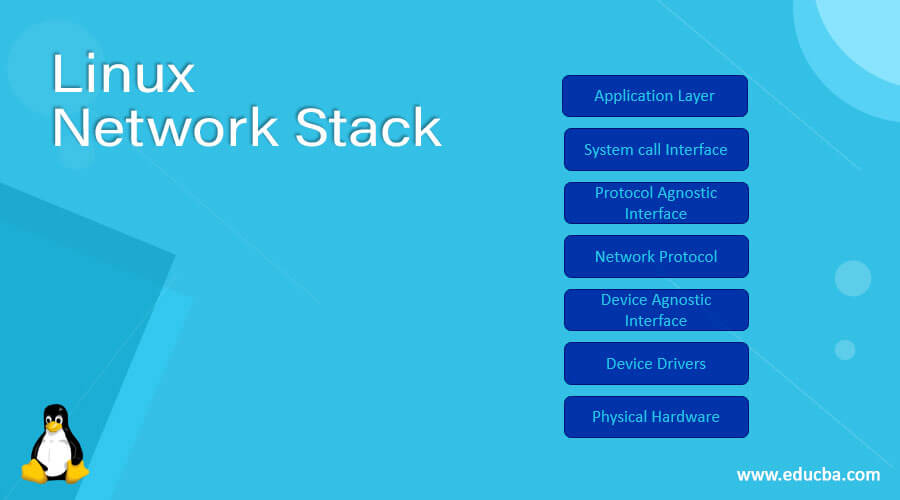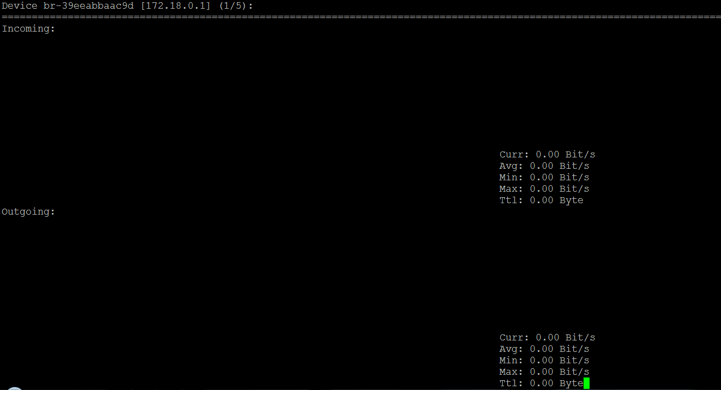Updated June 30, 2023
Introduction to Linux Network Stack
In the Linux operating system, the network stack is useful to communicate the application with the physical network devices. The network stack is divided into multiple layers. There are different network layers. The same different roles are playing their individual role. Generally, all the operating system supports the network stack role. With the help of the network, we are able to use or connect different network devices like routers, modems, cable modems, ISDN Mode, Wi-Fi devices, Ethernet cards, Broadband connectors, Token Ring cards, etc. While communicating with different devices, the physical layer comes into the picture. It represents the data in terms of bit format and communicates the different devices’ physical layers in bit format only.
Syntax of the Linux Network Stack
Network Command/Utility [ OPTION ] ... [ FILE / IP / INPUT FILE / …]- Network Command/Utility: We can use the “Network Command or Utility” keyword in the syntax or command as per the requirement and use. It will take different arguments like options, input files, IP addresses, and different compatible options. As per the provided arguments, it will provide network-related information on the screen.
- OPTIONS: We can provide the different flags as the option that is compatible with the “Network Command or Utility.”
- FILE / IP / INPUT FILE: As per the condition or requirement, we can provide different options or arguments to the “Network Command/Utility.”
How does the Linux Network Stack Works?
Linux is a multi-user support operating system and supports all the network stack functionality. While communicating with the network, it will follow the two ways of communication. First, the end-user or the client will request access or the file request. Second, as per the necessary access or request type, the request will full fill and set the acknowledgment to the end-user or the client. In this network process, several different network layers come into the picture.
Below is the list of layers that come into the picture.
- Application Layer
- System call Interface
- Protocol Agnostic Interface
- Network Protocol
- Device Agnostic Interface
- Device Drivers
- Physical Hardware
- Application Layer: It comes to the TCP and the UDP protocols. On the application layer, applications like different browser or other application which accesses the Internet work in this layer. Any application or jobs accessing the internet will be considered in the application layer. When we open or close any file on the network level with the help of any tool or application, it will rely on the same application.
- System Call Interface: The SCI stands for System Call Interface. The call will happen when the application layer to the kernel level. Let’s continue with the sample example of editing any image. We need to request the file from a network or remote location. In the same case, we send the read request to the kernel to edit the image.
- Protocol Agnostic Interface: In the Protocol Agnostic Interface, it will create the socket. The same created socket is responsible for the two types of communication i.e., talking or listening. Each socket has its own ID. The same id will further be used specifically for an application.
- Network Protocol: The Network Protocol is responsible for sending and receiving data. In other words, we can say that how the data is sent or received. The network layers control the send and receive information across the network. Specifically, the in-network layer work on the router level or router table. This layer is also providing the network routing information.
- Device Agnostic Interface: The Device Agnostic Interface is used to communicate or connect the data from or to the Kernel level and the network drivers or device drivers.
- Device Drivers: The Device Drivers Layer; in this layer, the real device driver of the network device will use. This layer is allowed to prepare the data for transmission. Once the data is ready for transmission, it will transmit the data over the network device.
- Physical Hardware: The Physical Hardware layer is also known as the hardware or network hardware. The data packets will transmit or receive from the network medium on the same layer. The network medium will be cable or wireless.
Examples to Implement Linux Network Stack
Lets us discuss the examples of Linux network stack.
-
Linux Network Stack: arpwatch
In the Linux network stack, the arpwatch is a utility to observe the Ethernet traffic activity. It will also observe the changing IP and MAC Addresses.
Command :
arpwatch -i enp0s3
tail -f /var/log/messagesExplanation :
As per the above command, we are using the network utility i.e. arpwatch. It is monitoring the activity on the “enp0s3” network interphase and if the arpwatch utility finds any changes in the interphase level. It will mark it in “/var/log/messages” file.
Output :
-
Linux Network Stack – ifstat
With the help of ifstat utility, we are able to get detailed information on the network interfaces.
Command :
ifstat enp0s3Explanation :
In the ifstat command, we get the detail information of the network interphase i.e. “enp0s3”.
Output :
-
Linux Network Stack – nload
With the help of nload utility, we are able to get detailed information about the network traffic.
Command :
nloadExplanation :
As per the above command, we are able to get the network load or traffic information on the system.
Output :
-
Linux Network Stack – hping
In Linux, we have the functionality to analyze the TCP and the IP things.
Command :
hping3 -S 192.168.56.60 -p 80Explanation :
As per the above command, we are analyzing the TCP port 80 on the IP address 192.168.56.60.
Output :
Conclusion
We have seen the uncut concept of “Linux Network Stack” with the proper example, explanation, and command with different outputs. It is very important to understand how the network flow is and which different layers comes into the picture while data is flowing in between the different application levels or job level.
Recommended Articles
We hope that this EDUCBA information on “Linux Network Stack” was beneficial to you. You can view EDUCBA’s recommended articles for more information.








